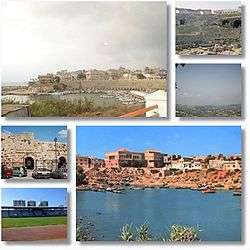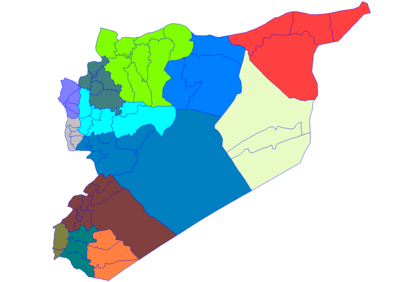Jableh
| Jableh جبلة جبلة الروح | |
|---|---|
|
A collage of Jableh. | |
 Jableh Location in Syria | |
| Coordinates: 35°21′N 35°55′E / 35.350°N 35.917°ECoordinates: 35°21′N 35°55′E / 35.350°N 35.917°E | |
| Country | Syria |
| Governorate | Latakia Governorate |
| District | Jableh District |
| Nahiyah | Jableh |
| Elevation | 16 m (52 ft) |
| Population | |
| • Total | 80,000 |
| Time zone | EET (UTC+2) |
| • Summer (DST) | EEST (UTC+3) |
Jableh (Arabic: جبلة; Ǧabla, also spelt Jebleh, Jabala, Jablah or Gabala) is a coastal city on the Mediterranean in Syria,[1] 25 km (16 mi) north of Baniyas and 25 km (16 mi) south of Latakia, with c. 80,000 inhabitants (2008). As Ancient Gabala it was a Byzantine (arch)bishopric and remains a Latin Catholic titular see. It contains the tomb and mosque of Ibrahim Bin Adham, a legendary Sufi mystic who renounced his throne of Balkh and devoted himself to prayers for the rest of his life.[2]
History

Jableh has been inhabited since at least the second millennium BCE.[3] The city was part of the Ugaritic kingdom and was mentioned as "Gbʿly" in the archives of the city c. 1200 BC.[4] In antiquity Jableh (then called Gabala) was an important Hellenistic and then Roman city. One of the main remains of this period is a theatre, capable of housing c. 7,000 spectators. Near the seashores even older remains were found dating to the Iron Age or Phoenician Era.
In the medieval period, Jableh was part of the Principality of Antioch, one of the Crusader States, until it was captured by Saladin in 1189 during the Third Crusade. One famous resident was Hugh of Jabala, the city's bishop, who reported the fall of Edessa to Pope Eugene III, and was the first person to speak of Prester John.
Less than 1 kilometer from the city centre lies the ancient site of Gibala, today known as Tell Tweini. This city was inhabited from the third millennium BCE until the Persian period.
On May 23, 2016, the Islamic State of Iraq and the Levant claimed responsibility for four suicide bombings in Jableh, which had remained largely unaffected since the Syrian Civil War began in 2011. Purportedly targeting Alawite gatherings, the bombs killed over a hundred people. In Tartus, similarly insulated, another three bombers killed 48 people.[5]
Ecclesiastical History
No later then the 4th century, Gabala became a bishopric in the Roman province of Syria Prima, suffragan of the Archdiocese of Seleucia Pieria. Later it was raised to a Byzantine autocephalous Archbishopric, remaining within the sway of the original Patriarchate of Antioch, apparently until the Muslims conquered all Syria.
- (Greek) (Arch)Bishops of Gabala
- Zoilus (recorded in 325)
- Severus (circa 347)
- Domninus (in 381)
- Severianus (early Vth century)
- Maras
- Pietro / Peter (first mention 451 - last 458)
- Giovanni / John (in 536)
- Romanus (in 553)
- Germanus
When the Crusaders conquered Gabala, it became a Latin bishopric in the Principality of Antioch, one of the Crusader States, until its capture by Saladin in 1189 during the Third Crusade, apparently under the Latin Patriarchate of Antioch.
- Latin Bishops of Gabala
- William/ Guglielmo (recorded in 1115)
- (H)Ugo (first mention 1136 - last 1144)
- V. (in 1179)
- Radulfo (in 1261)
- Gualterio di Calabria, Dominican Order (O.P.) (12 July 1264 - ?)
Latin Titular see
No later then the 16th century the (arch)diocese was nominally restored as Latin Titular bishopric of Gabala (Latin = Curiate Italian) / Gabalen(sis) (Latin adjective).
It has had the following incumbents, all of the fitting Episcopal (lowest) rank :
- Juan Martín (1513.11.04 – ?) as Auxiliary Bishop of Auxiliary Bishop of Urgell (Spain) (1513.11.04 – ?)
- Alfonso de Villasancta, Friars Minor (O.F.M.) (1526.02.21 – ?) as Auxiliary Bishop of Urgell (Spain) (1526.02.21 – ?)
- Bertrand Reydellet, Paris Foreign Missions Society (M.E.P.) (1762.07.27 – death 1780.07.27) first as Coadjutor Vicar Apostolic of Western Tonking (Vietnam; now Metropolitan Archdiocese of Hà Nôi) (1762.07.27 – 1764.10.19), then succeeding as Apostolic Vicar of Western Tonking (1764.10.19 – 1780.07.27)
- Viktor von der heiligen Maria Schwaiger, Teresian Carmelites (O.C.D.) (1787.11.09 – death 1793.05.31) as Apostolic Vicar of Great Mogul (British East India; now Metropolitan Archdiocese of Bombay) (1787.11.09 – 1793.05.31)
- James Duggan (1857.01.09 – 1859.01.21) as Auxiliary Bishop of Archdiocese of Saint Louis (USA) (1857.01.09 – 1859.01.21); later Bishop of Chicago (USA) (1859.01.21 – retired 1880.09.10), died 1999
- Patrick Dorrian (1860.06.23 – 1865.07.13) as Coadjutor Bishop of Down and Connor (Northern Ireland, UK) (1860.06.23 – 1865.07.13); later succeeded as Bishop of Down and Connor (1865.07.13 – death 1885.11.03)
- Jules Lepley (孟), M.E.P. (1871.12.22 – death 1886.09.24) as Apostolic Vicar of Southern Szechwan 南四川 (imperial China; now Diocese of Suifu) (1871.12.22 – 1886.03.06)
- Jacobus Glazer (1887.09.04 – death 1898?) Auxiliary Bishop of Diocese of Przemyśl (Poland) (1887.09.04 – 1898?)
- Alain Guynot de Boismenu, Sacred Heart Missionaries ( M.S.C.) (later Archbishop) (1899.05.23 – 1945.01.18) first as Coadjutor Vicar Apostolic of New Guinea (Papua New Guinea) (1899.05.23 – 1908.01), succeeding as Vicar Apostolic of New Guinea (1908.01 – 1922.11.14) and restyled first Vicar Apostolic of Papua (Papua New Guinea) (1922.11.14 – 1946); later 'promoted' on emeritate as Titular Archbishop of Claudiopolis in Honoriade (1945.01.18 – death 1953.11.05)
In ?1932 it was promoted as Latin Titular archbishopric of Gabala (Latin = Curiate Italian) / Gabalen(sis) (Latin adjective).
It has had the following incumbents, mostly of the fitting Archiepiscopal (intermediary) rank with an exception of Episcopal (lowest) rank :
- BIOs TO ELABORATE
- Ignazio Mobarak (1952.01.20 – 1958.05.19)
- Vivian Anthony Dyer (1959.04.25 – 1960.08.12)
- Gérard-Paul-Louis-Marie de Milleville, Holy Ghost Fathers (C.S.Sp.) (1962.03.10 – 2007.01.12)
- Titular Bishop: Ricardo Lingan Baccay (2007.02.23 – 2016.02.20)
- Archbishop-elect Santiago De Wit Guzmán (born Spain) (2017.03.21 – ...), as papal diplomat : Apostolic Nuncio (ambassador) to Central African Republic (2017.03.21 – ...).
Economy
The majority of people in Jableh depend on agriculture for their life, people grow orange and lemon trees, olives, a large number of green houses for vegetables can be found in the country side. In the center of the city people work in trade and there are small factories in the city for cottons and for making orange juice.
Notable locals
- Syrian pioneer of modern Arabic poetry Adunis.
- Izz ad-Din al-Qassam, a famous Islamic figure who fought against the French Colonization in Syria, and then moved to Palestine where he led an armed rebellion against the British authorities and Jewish colonists.
Sports
Jableh Sporting Club is a football (soccer) club based in Jableh, playing in the Al-Baath Stadium, which has a seating capacity of 10,000.
Climate
| Climate data for Jableh | |||||||||||||
|---|---|---|---|---|---|---|---|---|---|---|---|---|---|
| Month | Jan | Feb | Mar | Apr | May | Jun | Jul | Aug | Sep | Oct | Nov | Dec | Year |
| Average high °C (°F) | 12.8 (55) |
14.0 (57.2) |
17.7 (63.9) |
21.4 (70.5) |
25.0 (77) |
28.3 (82.9) |
30.0 (86) |
28.8 (83.8) |
27.6 (81.7) |
26.5 (79.7) |
21.5 (70.7) |
15.5 (59.9) |
22.43 (72.36) |
| Average low °C (°F) | 7.3 (45.1) |
7.8 (46) |
9.9 (49.8) |
12.4 (54.3) |
15.5 (59.9) |
19.4 (66.9) |
22.2 (72) |
22.3 (72.1) |
19.8 (67.6) |
16.7 (62.1) |
12.3 (54.1) |
8.9 (48) |
14.54 (58.16) |
| Average precipitation mm (inches) | 159 (6.26) |
130 (5.12) |
109 (4.29) |
50 (1.97) |
28 (1.1) |
4 (0.16) |
1 (0.04) |
1 (0.04) |
15 (0.59) |
52 (2.05) |
89 (3.5) |
190 (7.48) |
828 (32.6) |
| Average rainy days (≥ 1 mm) | 14 | 12 | 11 | 8 | 4 | 1 | 1 | 1 | 2 | 6 | 9 | 12 | 81 |
| Source #1: http://www.worldweatheronline.com/jableh-weather-averages/al-ladhiqiyah/sy.aspx | |||||||||||||
| Source #2: http://en.climate-data.org/location/47687/ | |||||||||||||
See also
References
- ↑ "Gabala". Catholic Encyclopedia.
- ↑ Google Books Travels In Asia And Africa, 1325-54 By Battuta Ibn, Ibn Batuta Translated by Sir Hamilton Gibb (1996) ISBN 81-206-0809-7 p. 62
- ↑ Esber, Hawazan. "Small historical coastal cities: Urban development and freshwater resources". NESCO. Retrieved 11 August 2015.
- ↑ William A. Ward, Martha Joukowsky (1992). The Crisis years: the 12th century B.C. : from beyond the Danube to the Tigris. p. 113.
- ↑ "IS blasts in Syria regime heartland kill more than 148", by AFP, via Channel NewsAsia
Sources and external links
- Bibliography - (arch)bishopric of Gabala
- Pius Bonifacius Gams, Series episcoporum Ecclesiae Catholicae, Leipzig, 1931, p. 434
- Michel Lequien, Oriens christianus in quatuor Patriarchatus digestus, Paris, 1740, Vol. II, coll. 797-800
- Konrad Eubel, Hierarchia Catholica Medii Aevi, vol. 1, p. 257; vol. 2, p. 156; vol. 3, p. 200; vol. 6, pp. 221–222
- Charles Du Fresne Du Cange, Les Familles d'outre-mer, Paris, 1869, pp. 795–796
- Siméon Vailhé, Notes de géographie ecclésiastique, in Échos d'Orient, Vol. IV (1900), pp. 15–17.

